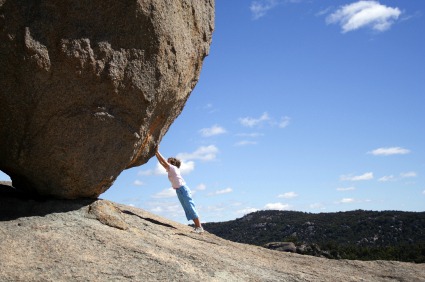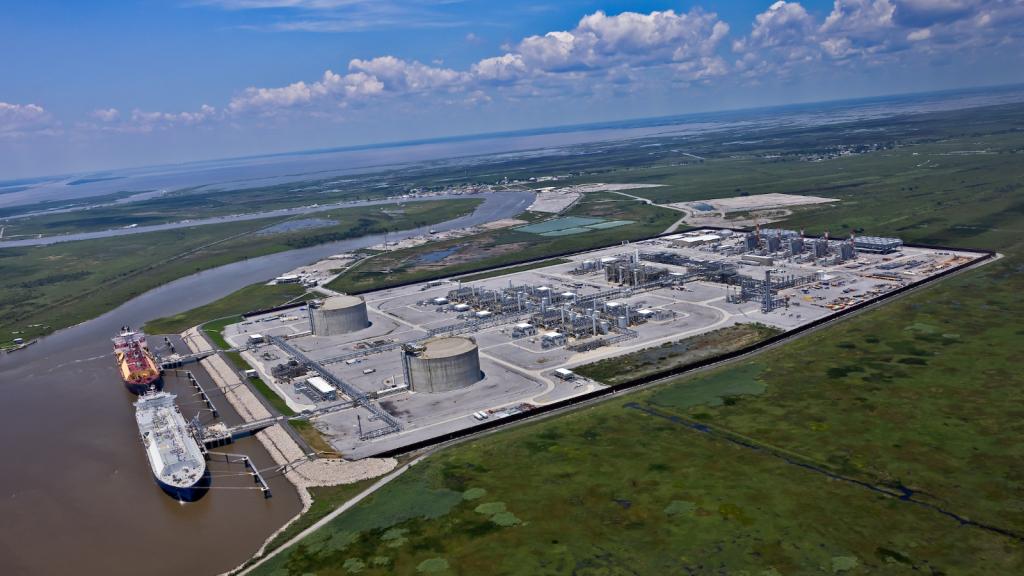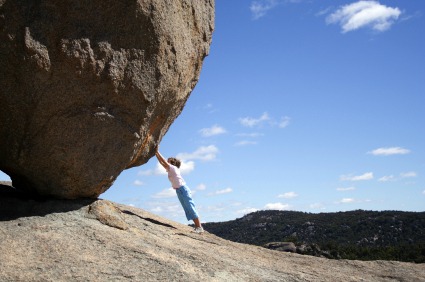 The consensus in American politics today is that there’s nothing to be gained from talking about climate change. It’s divisive, the electorate has more pressing concerns, and very little can be accomplished anyway. In response to this evolving consensus, lots of folks in the climate hawk coalition (broadly speaking) have counseled a new approach that backgrounds climate change and refocuses the discussion on innovation, energy security, and economic competitiveness.
The consensus in American politics today is that there’s nothing to be gained from talking about climate change. It’s divisive, the electorate has more pressing concerns, and very little can be accomplished anyway. In response to this evolving consensus, lots of folks in the climate hawk coalition (broadly speaking) have counseled a new approach that backgrounds climate change and refocuses the discussion on innovation, energy security, and economic competitiveness.
This cannot work. At least it cannot work if we hope to avoid terrible consequences. Why not? It’s simple: If there is to be any hope of avoiding civilization-threatening climate disruption, the U.S. and other nations must act immediately and aggressively on an unprecedented scale. That means moving to emergency footing. War footing. “Hitler is on the march and our survival is at stake” footing. That simply won’t be possible unless a critical mass of people are on board. It’s not the kind of thing you can sneak in incrementally.
It is unpleasant to talk like this. People don’t want to hear it. They don’t want to believe it. They bring to bear an enormous range of psychological and behavioral defense mechanisms to avoid it. It sounds “extreme” and our instinctive heuristics conflate “extreme” with “wrong.” People display the same kind of avoidance when they find out that they or a loved one are seriously ill. But no doctor would counsel withholding a diagnosis from a patient because it might upset them. If we’re in this much trouble, surely we must begin by telling the truth about it.
So let’s have some real talk on climate change.
For today’s inconvenient truths (ahem), we turn to Kevin Anderson, a professor of energy and climate change who was, until recently, director of the U.K.’s leading climate research institution, the Tyndall Energy Program. Anderson is a publishing researcher himself and, in his capacity as Tyndall director, was responsible for weaving together multiple lines of research and evidence into a coherent story. This year, with his colleague Alice Bows, he published a paper called “Beyond ‘dangerous’ climate change: emission scenarios for a new world” [PDF]. If reading academic papers isn’t your thing, he also delivers a digestible presentation here, or here with slides. (Discovered via Alex Steffen’s excellent Twitter feed.)
Let’s walk through Anderson’s logic.
1. How much can global average temperature rise before we risk “dangerous” changes in climate? The current consensus answer is: 2 degrees C [3.6 degrees F] above pre-industrial levels.
The 2 degrees C number has been around for over a decade and was reaffirmed by the Copenhagen Accord just last year. Deciding on an “acceptable” level of temperature is a political and somewhat arbitrary judgment, of course, since it lets one number stand in for a wide range of heterogeneous considerations. But it’s an important marker. And when it was first developed, it was based on the science of the day.
Here’s a chart attempting to show, in simplified form, what amount of temperature rise will produce dangerous effects (the red zones) and what the 2 degrees C level means:
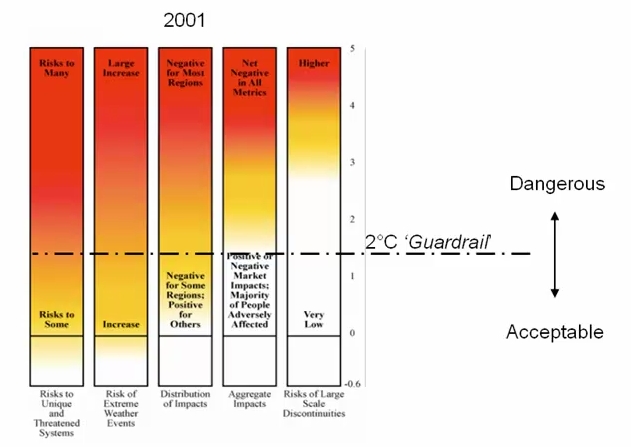 Click for larger version. Image: Kevin Anderson, “Beyond ‘dangerous’ climate change“
Click for larger version. Image: Kevin Anderson, “Beyond ‘dangerous’ climate change“
Seems sensible enough. But there’s a hitch: Climate science has not stood still for the last decade. According to the latest research, the level of damages once expected at 2 degrees C is now expected at considerably lower temperatures. Here’s a graph that shows science’s evolving understanding:
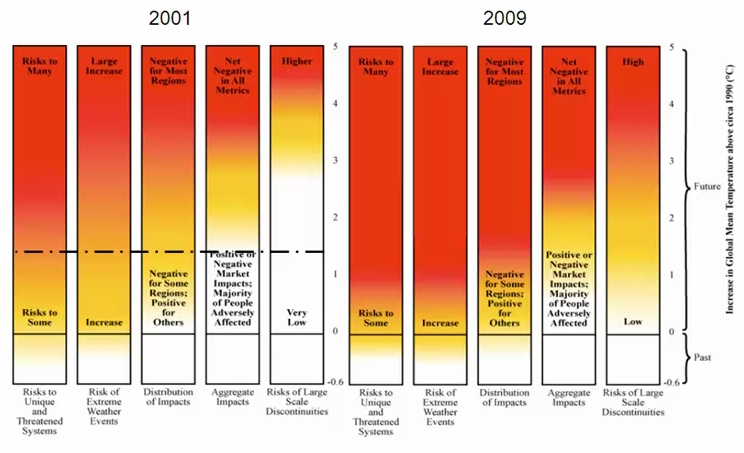 Click for larger version. Image: Kevin Anderson, “Beyond ‘dangerous’ climate change“
Click for larger version. Image: Kevin Anderson, “Beyond ‘dangerous’ climate change“
As you can see, the 2 degrees C “guardrail” that separated acceptable from dangerous in 2001 is, in 2009, squarely inside several red zones. Today, the exact same social and political considerations that settled on 2 degrees C as the threshold of safety by all rights ought to settle on 1 degree C [1.8 degrees F]. After all, we now know 2 degrees C is extremely dangerous.
At this point, however, stopping at 1 degree C is physically impossible (we can thank our past inaction for that). Indeed, as we’ll see, stopping at 2 degrees C is getting close to impossible as well. There is no longer any reasonable chance of avoiding “dangerous” climate change, so 1 degree C vs. 2 degrees C is a somewhat academic debate. At this point we’re just shooting to avoid super-duper-dangerous. Regardless, the numbers that follow are based on 2 degrees C.
2. For the purposes of limiting temperature rise to 2 degrees C, what matters is the total accumulation of greenhouse gases in the atmosphere — our “carbon budget.”
Anderson is adamant that the familiar targets almost all politicians and many scientists use in public — e.g., “80 percent reduction in the rate of emissions by 2050” — are deeply misleading. As far as the climate is concerned, the rate of emissions in 2050 relative to the rate of emissions today is meaningless. CO2 stays in the atmosphere for over a century; the atmosphere doesn’t care what year it arrives. (Though targets in the distant future are comforting to politicians, for obvious reasons.)
The only thing that matters in limiting temperature rise is cumulative emissions, the total amount we dump into the atmosphere this century. When the total concentration of GHGs in the atmosphere rises, temperature rises. That is the correlation that matters.
If we want to limit temperature rise to 2 degrees C or less, then there’s only so much carbon we can dump in the atmosphere. That is our “carbon budget” for the century, the amount we have to “spend” before we’re in the danger zone. As best we know, the global carbon budget for this century is between 1,320 and 2,200 gigatons (There are too many uncertainties in the science to be more precise than that.)
3. With a carbon budget, it’s possible to develop a carbon reduction pathway.
Once the global carbon budget has been determined (and divvied up among countries — more on that in subsequent posts), it’s possible to conceptualize a way reduce carbon fast enough to stay under that budget. Here’s a generic example of a carbon reduction pathway:
 Click for larger version. Image: Kevin Anderson, “Beyond ‘dangerous’ climate change“
Click for larger version. Image: Kevin Anderson, “Beyond ‘dangerous’ climate change“
A key fact to remember: For a given carbon reduction pathway, the later emissions peak, the faster they have to fall to stay under budget.
4. Any carbon reduction pathway that limits temperature rise to 2 degrees C shows global emissions peaking extremely soon and declining extremely quickly.
Right now, global emissions are rising, faster and faster. Between 2000 and 2007, they rose at around 3.5 percent a year; by 2009 it was up to 5.6 percent. In 2010, we hit 5.9 percent growth, a record. We aren’t just going in the wrong direction — we’re accelerating in the wrong direction.
(Most climate modeling scenarios, e.g. the Stern Report, underplay the current rate of emissions growth, leading to sunnier-than-justified results.)
The growth of emissions is making the task ahead more and more difficult. The longer we wait to start shrinking emissions, the faster we’ll have to shrink them to stay under budget. Here’s a visualization of what that means — some sample reduction curves with varying peak years (the four different lines are based on the four main IPCC scenarios):
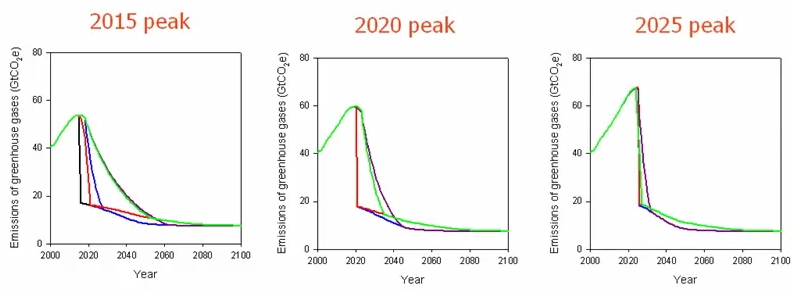 Click for larger version. Image: Kevin Anderson, “Beyond ‘dangerous’ climate change“
Click for larger version. Image: Kevin Anderson, “Beyond ‘dangerous’ climate change“
As you can see, if we delay the global emissions peak until 2025, we pretty much have to drop off a cliff afterwards to avoid 2 degrees C. Short of a meteor strike that shuts down industrial civilization, that’s unlikely.
How about 2020? Of the available scenarios for peaking in 2020, says Anderson, 13 of 18 show hitting 2 degrees C to be technically impossible. (D’oh!) The others involve on the order of 10 percent reductions a year after 2020, leading to total decarbonization by 2035-45.
Just to give you a sense of scale: The only thing that’s ever pushed emissions reductions above 1 percent a year is, in the words of the Stern Report, “recession or upheaval.” The total collapse of the USSR knocked 5 percent off its emissions. So 10 percent a year is like … well, it’s not like anything in the history of human civilization.
This, then, is the brutal logic of climate change: With immediate, concerted action at global scale, we have a slim chance to halt climate change at the extremely dangerous level of 2 degrees C. If we delay even a decade — waiting for better technology or a more amenable political situation or whatever — we will have no chance.
5. Jeez, 2 degrees C looks hard. Can we just do 4 degrees C [7.2 degrees F] instead?
It might seem that, given the extraordinary difficulty of hitting 2 degrees C, we ought to lower our sights a bit and accept that we’re going to hit 4 degrees C. It won’t be ideal, but hitting anything lower than that is just too difficult and expensive.
It’s seductive logic. After all, to hit 4 degrees C we would “only” have to peak global emissions in 2020 and decline thereafter at the relatively leisurely rate (ha ha) of around 3.5 percent per year.
Sadly, even that cold comfort is not available to us. The thing is, if 2 degrees C is extremely dangerous, 4 degrees C is absolutely catastrophic. In fact, according to the latest science, says Anderson, “a 4 degrees C future is incompatible with an organized global community, is likely to be beyond ‘adaptation’, is devastating to the majority of ecosystems, and has a high probability of not being stable.”
Yeeeah. You’ll want to read that sentence again. Then you’ll probably want to pour yourself a stiff drink.
Obviously, “incompatible with an organized global community” is what jumps out, but the last bit, “high probability of not being stable,” is equally if not more important. One of the most uncertain areas of climate science today has to do with feedbacks — processes caused by climate change that in turn accelerate (or decelerate) climate change. For instance, heat can melt the Arctic permafrost, which releases methane, which accelerates climate change, which melts more permafrost, etc.
Based on current scientific understanding, positive climate feedbacks — the ones that accelerate the process — considerably outweigh negative feedbacks. At some level of temperature rise, some of those positive feedbacks are likely to become self-reinforcing and effectively unstoppable, no matter how much emissions are cut. These are the “tipping points” you hear so much about.
But at what level? Will hitting 2 degrees C trigger runaway positive feedbacks? It’s difficult to know; this is one of the most uncertain areas of climate science. James Hansen thinks 2 degrees C will do it. Others disagree.
But the situation becomes considerably clearer around 4 degrees C. At that level, there’s good reason to believe that some positive feedbacks will become self-reinforcing. In other words, 4 degrees C would very likely be a way station on the road to much higher temperatures.
That makes the notion of “adapting” to 4 degrees C a bit of a farce. Infrastructure decisions involve big money and long time horizons. By the time we’ve built (or rebuilt) infrastructure suited to 4 degrees C, it will be 5 degrees C [9 degrees F]. And so on. A climate in which conditions are changing that fast just isn’t suitable for stable human civilization (or for the continued existence of a majority of the planet’s species).
Oh, and by the way: According to the International Energy Agency, we’re currently on course for 6 degrees C [10.8 degrees F]. That is, beyond any reasonable doubt, game over.
So this is where we’re at: stuck between temperatures we can’t possibly accommodate and carbon reduction pathways we can’t possibly achieve. A rock and a hard place.
What does it mean for the way we think about climate policy? I’ll address that in my next post.

